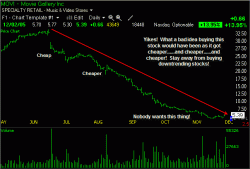Diversification for Traders
December 9, 2005 at 9:17 am
They send me junk all the time, as if I really care.
Those long-term accounts of mine are magnets for the endless supply of “investment” idea brochures and write-ups.
It’s all about diversification, they say.
But I’m a trader! Can I still diversify? YES, and I should. But it isn’t the same. It’s not about finding some international exposure to offset the large cap growth in my portfolio (did I just say “portfolio?”). No, diversification in my world as a trader is entirely different.
I can diversify my timeframes. I may choose to day trade some of my funds, looking for quick intraday moves while I let a swing trading position play out over the course of a few days. I can diversify my timeframes by checking not just the 3-minute chart but also noticing what the 15 or 60-minute charts show. That’s something that can help me as a trader when I am trying to determine my next course of action (or inaction).
I can diversify the sectors I trade. Maybe I trade semiconductors on a day like today when they’re the talk of the NAZ, and other days I turn to the homebuilders or the energy stocks for movement. The bird flu plays have been active in recent weeks, and they move to the beat of their own drummer. Diversifying sectors allows me to find exposure in places that will move with the market or not at all, which it helps to stay aware of on trend days as well as range bound days.
I can diversify my trading by going long or short. It cracks me up when people I know see the DJIA down 80 points and think I must have lost money. They forget I’m a trader. It’s about movement, not always price appreciation. I can go long or I can short sell and still make money as long as I’m paying attention to the market.
Diversify your timeframes, the sectors you trade, and be willing to go short. And when you get a chance, trash that value fund prospectus!
Jeff White
President, The Stock Bandit, Inc.
www.TheStockBandit.com
Selling Your Stock – When and Why
December 8, 2005 at 2:20 pm
There’s another side to look at. It’s not all about buying. It’s not all about knowing where the entry is and when you should get in. Trading well doesn’t just come down to some timing indicators that tell you when to get long. To make money in this game, you’ve got to sell, and you’ve got to do it at the right time.
When it comes to selling, knowing your exit ahead of time is half of the battle. Trading according to a plan will take you miles beyond the results you see if you trade on whims. Is this a momentum trade? Is this a swing trading candidate? Is this a trend trade with a trailing stop, or am I looking for a particular number to be reached before I sell? These are the kinds of questions to ask going into the trade.
Once you’re in the trade, there are a number of reasons to sell your stock:
The most common time to sell out all of your stock is when you’re just plain wrong. You’ll know when you’re wrong, because your P&L will tell you so, every minute, tick by tick, dollar for dollar. When your stop-loss gets triggered, sell out! Be disciplined and pull the trigger when the time comes to do so, or else set an automatic stop-loss order through your broker.
Selling in the face of a stagnating market is also wise. Perhaps you caught a nice move but the trend has since stalled out. Your stock hasn’t yet rolled over, but it’s not going higher anymore either. Reducing your exposure and freeing up cash in a market that isn’t moving means less risk to you. You will then have cash on hand to put into new trades, whether for new buys or for short selling stocks if the market weakens.
When your profit objective has been met, do some selling. Making sales after an advance to the area you planned to see is simply good trading discipline. Sell all of your stock if it is now facing overhead resistance, because you can always re-buy if and when the stock clears resistance and breaks out. There’s just no reason to own a stock in an area where the sellers clearly have had an advantage.
You don’t have to sell it all at once! Many traders think they are either in or out of a trade. They look at it like it’s an all-or-nothing type of thing, and it doesn’t have to be that way. In fact, in many cases, it shouldn’t be that way. If you are following a trend, it’s often wise to make partial sales along the way. This books incremental profits, while freeing up cash for other trading ideas. It also helps to satisfy that urge to sell that so many of us fight. Selling off stock in pieces as the trade shows you a profit is a good way to manage money AND emotions.
When you plan your next trade, consider where you will want to sell and where you’ll need to sell. Whether it’s on the profit or loss side, know your exit!
Jeff White
President, The Stock Bandit, Inc.
www.TheStockBandit.com
Trading Without Emotion
December 7, 2005 at 2:56 pm
Making and losing money in the blink of an eye while trading evokes all sorts of emotions. It’s so easy to get excited when a trade develops exactly like your plan. It’s equally easy to get frustrated and mad when a stock goes the wrong way and you know another trader is collecting on your mistake (that lucky chump!).
But when was the last time your emotions helped you in a trade? Has that positive excitement ever been costly to you, causing you to either book profits too early or stay in too long (feeling like it was easy)? Has your anger ever led you to put on grudge-trades, trying to “make back” your money quickly after a loss? It’s obvious to see that emotions are detrimental to your wealth!
I took up golf seriously when I was 13. My dad had always been a scratch player, so I had a great teacher for all aspects of the game. After I had been practicing and playing every day for several months, an important day arrived. He and I were playing golf one afternoon and on the 9th green, I had my first putt ever to break 40. It was about 2 ½ feet long and I should have been able to make it in my sleep. BUT, I was focused on my score rather than the process. I missed the putt, shot 40, and was mad the rest of the day. I wondered how long I’d have to wait for another chance at a meaningful putt like that. My Dad made some comments which helped me then and continue to help me now. He said I rushed my effort and was clearly thinking about score (results) rather than making the putt (the process). He suggested I implement a pre-shot routine, which is a mental and physical checklist to go through prior to each shot. Doing so would help me to focus on the process rather than the result. I broke 40 a few days later, excited about this new discovery.
Trading with a systematic approach can have the same positive effects on your profitability that my pre-shot routine gave me in golf. Even if you take discretionary trades, going through a routine and focusing on the process will let you execute your trading plan much better than watching your account balance fluctuate and having your emotions flutter just as often. This might mean that each evening you do some research or screen for chart patterns. It might mean you read a stock newsletter, scan the news, or set up conditional alerts as a safety net to your trading. Maybe it just means you go through the same routine each morning, adding some structure to your day and leveling out your emotions. Whatever it may mean for you, I highly suggest implementing some kind of trading routine to help combat the emotions that every one of us faces with trading. You’ll have time to do all of your celebrating later!
Jeff White
President, The Stock Bandit, Inc.
www.TheStockBandit.com
Downtrending Stocks – Don’t Buy!
December 6, 2005 at 4:32 pm
Everyone wants a great deal. If you don’t think so, just consider the day-after-Thanksgiving sales with people lined up outside the stores at 5am to buy merchandise on sale. We want things now and we want them cheap! When it comes to stocks, however, I know better.
They say to buy low and sell high. It’s a good concept if you can get it to work, but it implies that buying low is the first thing to do. Novice stock traders look to buy “cheap” stocks, whether it’s just a low-priced stock or a stock well off its highs. Remember, cheap stocks tend to be cheap for a reason!
Low-dollar stocks often fall into one of two categories: the former high-fliers which have split so many times and come down so far that they are simply too liquid and “thick” to make much of a move (LU, NT, etc.), and stocks which are cheap because they fizzled out long ago and no buzz has been generated since. These kinds of stocks don’t move enough for an active trader, unless you are as interested in trading so many shares that your broker makes as much in commission as you do in profits.
A downtrending stock is making lower highs and lower lows. Money is coming out of it. People are walking away in search of finding something more attractive. When you buy a stock, you want it to go up, so look for stocks with some buzz, some positive activity, and some momentum.
An example of how disastrous it can be to buy a downtrending stock is MOVI. This stock began trending lower many months ago, and has shed most of its value.
Consider the novice traders who wanted to buy a stock off its highs. They may have moved in to pick up shares in late June near $27 or so, which was more than $7 off the recent high. Those buyers never saw their trade turn profitable. What if they “averaged down” in the $20 area, hoping to catch a quick bounce to let them out? All they did was compound their losses. What about now that the stock is trading near $5.00? Would you feel like getting up and running after falling off a 20-story building? This stock probably doesn’t either. It’s best to stay away from chart patterns like this until the buyers regain control and the stock begins to build some upside momentum.
Buying stocks in downtrends is a recipe for disaster. Save your bargain-hunting for the retail stores and holiday shopping, but prepare to pay up if you want to buy a stock and turn a profit!
Jeff White
President, The Stock Bandit, Inc.
www.TheStockBandit.com
Welcome to TheStockBandit.net!
December 5, 2005 at 3:25 pm
Swing Trading With The Stock Bandit has been relocated to this new domain in order to provide more features and functionality! WordPress is now the backbone of this blog, allowing me much greater flexibility.
Please update your feeds and email subscriptions to this blog using the buttons (or e-mail field) in the sidebar to the right!
As always, interaction with readers is great, so don’t hesitate to post your comments and/or contact me whenever you like, and thanks for reading!
Jeff White
President, The Stock Bandit, Inc.






